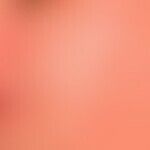Synonym(s)
DefinitionThis section has been translated automatically.
Acute, sub-acute or chronic dermatitis caused by contact with locally acting allergens (mostly in type IV allergy -s.a. allergy, type IV reaction). In contrast to toxic contact dermatitis, allergic contact dermatitis requires sensitization.
The extent of the skin inflammation depends on the degree of sensitization and the intensity (duration, occlusion, moisture, pressure, localization) of the allergen contact.
Rarely does an immediate type (atopy patch test, type IV reaction to type I allergens) reaction trigger allergic contact dermatitis.
ClassificationThis section has been translated automatically.
A distinction must be made between a:
- Acute allergic contact dermatitis (acute allergic contact eczema)
- Chronic allergic contact dermatitis (caused by repetitive contact with the triggering allergen; later, the course of the disease is self-dynamic due to a non-specific irritability of the skin)
You might also be interested in
Occurrence/EpidemiologyThis section has been translated automatically.
The disease is one of the most common skin diseases in Germany. Prevalence: 5-15% (depending on method) of the total population. For contact dermatitis as a whole (allergic+toxic) about 80% are classified as toxic-irritant, 20% as allergic contact dermatitis.
Affected body regions and contact allergens relevant there (varies according to F.Rueff et al.)
- Capillitium: hair care products, hair dye
- Forehead region: hair care products, hair dye, protective masks, hair nets, hat band, aerogenically transferred
- Eyelids: cosmetics, ophthalmics, contact lens fluids, nail polish
- Ears: jewellery, spectacle frames, hearing aids, otologic
- Oral mucosa: Oral and dental hygiene products, dental materials, nutritive substances, chewing gum
- Face: Cosmetics, toiletries, hair care products and cosmetics, sunscreens, protective masks, airborne allergens (composite mix, fragrances, epoxy resin)
- Neck: jewellery, cosmetics, toiletries, sunscreens, airborne allergens (composite mix, fragrances, epoxy resin), scarves, wool or fur collars, preservatives in ironing sprays
- Underarms: cosmetics (deodorants), toiletries, clothing,
- Hull: jewellery, clothing, cosmetics, toiletries
- genitalia: clothing, cosmetics, toiletries; condoms, lubricants, disinfectants
- Arms: jewellery, clothing, cosmetics
- Hands: occupational substances, gloves (rubber auxiliaries, latex, chromates, dyes), skin care products, cosmetics, toiletries; jewellery
- legs: toiletries, cosmetics, stockings, other clothing, jewellery
- Lower leg: Topical therapeutics (for stasis dermatitis or leg ulcers): Fragrances, wool wax alcohols, cetylstearyl alcohol, neomycin, chloramphenicol, dexpanthenol, preservatives, benzocaine
- Feet: Footwear materials (chromates, rubber additives, adhesives), cosmetics, 'toiletries, antifungals, stockings
- Perianal: disinfectant, toilet paper, haemorrhoid therapeutics.
EtiopathogenesisThis section has been translated automatically.
ClinicThis section has been translated automatically.
24-48 hours after contact with the allergen, an erythema, which is usually blurred, clearly itchy, inflammatory, and interspersed with tiny blisters or even the smallest nodules, forms at the point of contact and later beyond the contact area. With increasing timeline, an inflammatory plaque develops, with vesicles, erosions, papules, even flat weeping.
Even after removal of the contact allergen, the inflammatory reaction can become even stronger (crescendo reaction). Severe contact allergic dermaitis is characterized by large blisters, and after they burst, by extensive erosion, weeping and crust formation.
Healing takes place under a rather coarse lamellar scaling of the skin.
If the allergen is not known and repeated contact with the allergen occurs, this leads to chronic dermatitis (chronic eczema), with initially local scattering phenomena; in the case of strong sensitisation, generalised scattering phenomena may also occur.
The picture of chronic contact allergic dermatitis differs significantly from the acute reaction. Now a rather multiform picture is impressive with flat, lichenified, scaly, greyish-red plaques interspersed with erosions, scaly crusts, rhagades.
In these chronic skin inflammations, the connection with the "actual" triggering agent is increasingly obscured, and must be painstakingly determined by anamnesis.
TherapyThis section has been translated automatically.
Avoid the triggering noxious agent. Testing of ointment compatibility as soon as possible (epicutaneous, lapping test, quadrant test), avoidance of incompatible ingredients, e.g. in cosmetics (see INCI labelling below). If possible, indifferent basics. Especially avoid wool wax and wool wax alcohols.
External therapyThis section has been translated automatically.
Acute contact dermatitis: According to the stdium of the skin inflammation, initially medium to strong glucocorticoids in an aqueous basis such as 0.1% amcinonide as cream or lotio (e.g. Amciderm), 0.1% hydrocortisone butyrate (e.g. Laticort cream), 0.25% prednicarbate (e.g.Dermatop cream/ointment), 0.1% mometasone (e.g. Ecural cream/ointment), furthermore moist compresses with NaCl-solution, in case of persistent superinfection with antiseptic additives like quinolinol (e.g. Chinosol 1:1000), R042 or potassium permanganate (light pink).
In the vesicular stage, a more lipid-moist treatment with e.g. hydrocortisone 1% in Vaselinum alb. (hydrocortisone ointment 1%)and moist compresses, cotton gloves if necessary.
Chronic contact dermatitis: Initial glucocorticoids externally with medium to strong efficacy in as fatty a base as possible such as 0.1% amcinonide (e.g. Amciderm ointment/fatty ointment), 0.25% prednicarbate (e.g. Dermatop ointment/fatty ointment), 0.1% hydrocortisone butyrate (e.g. Laticort cream), in the case of strongly scaly hyperkeratotic forms also under occlusion. S.a.u. eczema, hand eczema.
Leave out soaps and detergents, cleaning with oil-containing baths (Balneum Hermal, Balmandol, Linola grease oil bath). Try antiphlogistic topicals such as Pix lithanthracis 2%. After-treatment with replenishing externa in a compatible basis (Alfason repair, Linola Fett, Vaselinum alb., Excipial Almond oil ointment), if necessary addition of 2-10% urea (e.g. Eucerin Urea, Basodexan fat cream/ointment, R102 ). If necessary also use Zarzenda cream (internationally known as Atopiclair). This is a steroid-free multi-component cream with a strong anti-itching, anti-inflammatory effect (apply 2 times/day).
Internal therapyThis section has been translated automatically.
Acute contact dermatitis: In the case of highly acute courses of glucocorticoids as in medium to high dosages, e.g. prednisone 100-150 mg/day i.v. Change to oral therapy, rapid dosage reduction and balancing according to the clinical findings within 1 week. Additional antihistamines such as desloratadine (e.g. Aerius) 1-2 tbl/day or levocetirizine (e.g. Xusal) 1-2 tbl/day. S.a.u. Eczema.
LiteratureThis section has been translated automatically.
- Bernstein DI et al (2003) Clinical and occupational outcomes in health care workers with natural rubber latex allergy. Ann Allergy Asthma Immunol 90: 209-213
- Birk RW et al (2001) Alternative activation of antigen-presenting cells: concepts and clinical relevance. Dermatologist 52: 193-200
- Blauvelt A et al (2003) Allergic and immunologic diseases of the skin. J Allergy Clin Immunol 111: 560-570
- de Groot AC et al (1997) Conversion of common names of cosmetic allergens to the INCI nomenclature. Contact Dermatitis 37: 145-150
- Loffler H et al (2000) Irritant contact dermatitis. dermatologist 51: 203-21
- Mahler V (2015) Contact eczema. Act Dermatol 40: 95-107
- Schempp CM et al (2002) Plant-induced toxic and allergic dermatitis (phytodermatitis). Dermatologist 53: 93-97
- Schnuch A et al (2001) Information Society of Dermatological Clinics. Clinical epidemiology for prevention of allergic contact eczema. dermatologist 52: 582-585
- Smith Pease CK et al (2003) Contact allergy: the role of skin chemistry and metabolism. Clin Exp Dermatol 28: 177-183
RueffF et al (2018) Toxic and allergic contact dermatitis. In: Braun-Falco`s Dermatology, Venerology Allergology G. Plewig et al. (Hrsg) Springer Verlag S 1527
Incoming links (5)
Atopic juvenile plantar dermatosis; Cimicose; Curry; Framycetin; Morbus Morbihan ;Outgoing links (35)
Adhesion molecules; Amcinonide; Antigen; Bufexamac; Cobalt salts; Contact allergy (overview); Cytokines; Desloratadine; Dibromdicyanobutane; Eczema (overview); ... Show allDisclaimer
Please ask your physician for a reliable diagnosis. This website is only meant as a reference.











































